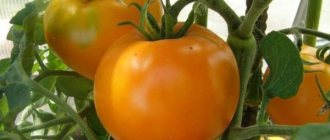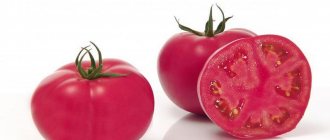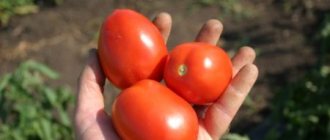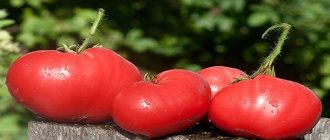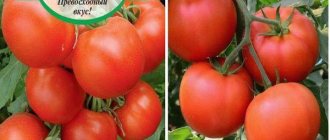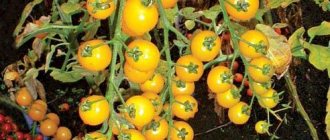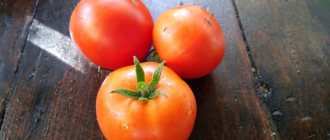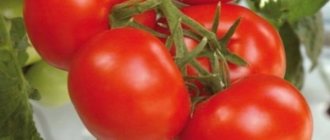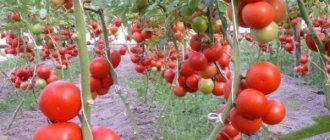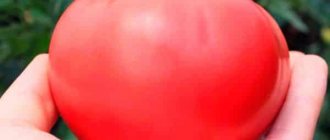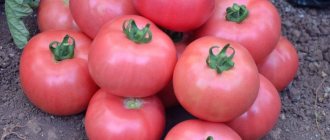Tomato Big Orange F1 is a tasty, juicy and productive hybrid that can be grown for personal use or for sale. It sets fruit well and resists disease and stress well.
| Height | Landing location | Ripening time | Fruit color | Fruit size | Origin | Fruit shape |
| Tall | Greenhouse | Early ripening | Orange | Large | Hybrid | Flat-round |
Description and characteristics of the variety
The hybrid Big Orange F1 has indeterminate bushes reaching 170 cm. Tomatoes ripen in clusters of 5-6 pieces, with 7 clusters developing on the stem. The fruits have a flat-round shape and a bright orange color. They are quite large, 200-270 g. They ripen in 90-100 days from the moment the crops germinate. The taste is excellent.
Big Orange: video
Tomato Big Orange F1 is a tasty, juicy and productive hybrid that can be grown for personal use or for sale. It sets fruit well and resists disease and stress well.
| Early ripe (90-105 days) | Indeterminate (170 cm) | Salad | For greenhouses | 170-270 | 20-25 kg | Orange. Round, dense, smooth. 5-6 pieces per brush |
| Height | Landing location | Ripening time | Fruit color | Fruit size | Origin | Fruit shape |
| Tall | Greenhouse | Early ripening | Orange | Large | Hybrid | Flat-round |
New tomato products from Semko for 2021. Let's get to know each other better
Well, I’ll start with gratitude to my dear subscribers for pushing me to study the next agricultural company in my reviews of new products. It became “Semko” - unfortunately, I knew nothing about it, since seeds under this trademark never fell into my hands.
I bought everything that was brought to markets and stores, and among others, I somehow didn’t come across them, I don’t know for what reason. And I already managed to regret it. I'll tell you why.
Firstly
, strange as it may sound,
“word of mouth”.
Not one or two subscribers praised the products of this company.
Secondly, the range
is truly wide.
Thirdly
,
attitude to work
. Since the reviews about these seeds are only good, I assume that the guys take the quality of their products seriously.
There is one minus, but quite significant. This is the price.
It is quite impressive; for some varieties, prices reach up to 90 rubles per bag, and they are packaged in 5 pieces per package. Agree, it’s a little expensive to pay 45 rubles (the average retail price of a package) for five seeds. In this case, the manufacturer indicates the percentage of germination and other important characteristics. You have to pay for quality - this is also an axiom, but many people simply cannot afford such seeds. Especially for pensioners who live on one pension and for whom a vegetable garden is a huge help.
Well, this is the first impression for now. Now I’ll move directly to the review.
There are not so many new products among the variety in the collection of tomatoes from Semko. I will try to briefly describe the advantages of each of them:
1. Bokele (60) F1
.
Pink-fruited tomatoes with a beautiful intense pink color of the fruit. Determinate variety, early ripening, suitable for cultivation both in greenhouses and in open ground. The fruits are large, bloom together, have high yields and are resistant to a number of diseases. There are 10 seeds in a package, the price of pleasure is 36 rubles
with a discount - the most inexpensive in today's review.
2. Tomato Bigorange plus F1.
Hybrid, fruits are round-oval, drying towards the bottom, intensely orange in color.
Externally they are very reminiscent of persimmon. Tomatoes of this variety have excellent taste and transportability; the bushes themselves are resistant to viral and fungal infections. There are 5 seeds in a package, the price per bag is 55 rubles.
3. F1 finalist
– another new product in the Semko tomato line.
A nice large-fruited beef class tomato, designed for growing in a greenhouse. The fruits themselves are bright scarlet, flat-round, fleshy and very tasty. The manufacturer promises high quality of the resulting fruits - they are stored for a long time and do not crack. The package, according to tradition, contains 5 pieces of seeds, the asking price is 55 rubles
.
4. Pink Cube F1
– the photo is just a sight for sore eyes, not tomatoes.
Nice “cream” of intense pink color, large-fruited variety. The fruits are smooth, fleshy, elastic, and have a high taste. This variety is also stress-resistant, tolerates temperature swings well and is perfect for growing in a greenhouse. Delicious, not tomatoes! Of all the tomatoes in my review, I would plant this particular variety - somehow I liked it. There are 5 seeds in a bag, the cost is 55 rubles
per pack.
Advantages and disadvantages
This hybrid has many positive qualities. Bigorange tomato is different:
- resistance to the main diseases characteristic of this culture;
- good tolerance to hot weather;
- good yield indicators;
- friendly ripening of fruits with good tomato taste.
Ripe fruits do not crack, can withstand transportation, and last well after picking, but not for too long. Harvested tomatoes can be stored without loss of appearance and taste for 2 weeks. Used fresh, they look beautiful in salads.
Advice. The harvested crop can also be used to prepare a variety of dishes.
No particular disadvantages were identified in the hybrid. Some disadvantages include only the need to tie the plant stems to supports and timely removal of stepsons.
F1 hybrid tomatoes for the Moscow region. Personal rating.
Nowadays, both among some professional agronomists and among amateur vegetable growers, there is no consensus on what is better to sow - varietal seeds or hybrid ones?
We will not talk about what is better and what tastes tastier - this is a topic for a separate article. And since this article will focus exclusively on hybrids, we will show what advantages the use of first generation F1 tomato hybrids provides compared to varieties. So, the use of hybrids provides the following advantages: - increased productivity; — significant increase in early maturity; — the same height of plants, which simplifies the technology of their cultivation; — uniformity of fruit size within one inflorescence; — uniformity of fruit color, obtaining a stable and even color of the fruit, without spots; - obtaining high quality fruits, including biologically valuable content (high content of sugars and dry substances, carotenoids and lycopene, vitamin C); — higher plant resistance to diseases and pests; — higher adaptability of plants to changing environmental conditions; — the possibility of quickly combining yield, early maturity, and disease resistance in the first generation F1 hybrid, which is impossible or requires a long time when obtaining varieties.
We really like Semkovsky (Semka-junior) seeds. With them, over many years of use, we have never had a mismatch and almost always have 100% germination, without any additional processing. Their only drawback is perhaps their high price. So below, we will talk exclusively about their F1 tomato hybrids, which we grew in a far from ideal greenhouse. But nevertheless, the harvest was always at its best, unlike the neighbors with their newfangled polycarbonate greenhouses.
Here is a small rating of tomato hybrids from our website, grown last year in the southern Moscow region. We warn you right away that the rating does not pretend to be a 100% objective assessment. But our personal opinion is fully reflected.
F1 - Gilgal.
Indeterminate, with compact brushes. From germination to fruit ripening, 110-115 days pass. The first inflorescence of Gilgal is formed above the 6-7 leaf, the next ones after 2-3 leaves. The cluster contains 3-5 fruits. The fruits are red, flat-round, slightly ribbed, multi-chambered, dense, weighing 250-300 g. Transportability, taste and keeping quality are good. Hybrid Gilgal F1 is intended for fresh consumption, suitable for growing in greenhouses, film tunnels and in open ground in a stake culture (planting density 2.5-3.0 plants/m2). Plants are formed into one stem if it is necessary to obtain large fruits, or into two stems if it is necessary to obtain fruits weighing over 200 g. The hybrid is resistant to tomato mosaic, tomato bronze virus, fusarium and verticillium wilt, cladosporiosis and root-knot nematodes. Tolerates temperature changes well. The yield of Gilgal in glass greenhouses is more than 36 kg/m2, in film tunnels it is more than 15 kg per plant.
The F1 Gilgal hybrid has proven itself very well in all respects. We grow this tomato year after year and always get high yields, tasty, fleshy, large fruits. 10 points out of 10.
F1 - Malika.
The plant is of a generative type, compact, with short internodes. Fruit ripening on the 108th day after full germination. The first cluster with 4-6 fruits is placed above the 11th leaf. The fruit is flat-round, slightly ribbed, multi-locular, bright red, without a green spot at the stalk, weighing 250-300 g. Resistant to fruit cracking. Tolerates high and low air temperatures well. The taste and marketability of the Malika tomato are excellent, and transportability is good. Shelf life is average (up to 14 days). Hybrid Malik F1 is resistant to tomato mosaic virus, cladosporiosis, fusarium, verticillium and nematodes, and tolerant to gray rot.
Just like Gilgal, Malika is an excellent solution for gardeners and gardeners in the Moscow region, and not only. High yield, unpretentiousness, tasty, fleshy large fruits. Behaves well in seedlings. 10 points out of 10.
F1 - Isfara.
Isfara F1 is a mid-early, determinate hybrid. From seed germination to the start of fruiting, 95-110 days pass. The plant is of a generative type, 1.5 m high. There are 4-6 fruits in the cluster. The tomato fruit is flat-round, multi-chambered, dense, red, without a green spot at the stalk, slightly ribbed, weighing 220-280 g. Resistant to cracking and temperature stress. The taste of fresh fruits is excellent. Shelf life up to 15-20 days. The hybrid is resistant to verticillium and fusarium, tomato mosaic virus, and nematode. Hybrid Isfara F1 is recommended for growing in film greenhouses and open ground with a garter to a support. Planting pattern 70x40 cm. Productivity over 20 kg/m2.
Features of agricultural technology and reviews
The tomato is intended for greenhouses. But in the southern regions, in conditions of stable heat, you can try to grow it without shelter, simply planting it in the garden in unprotected soil.
The hybrid is grown in seedlings with picking into separate pots when the seedlings have 2 leaves. A few days before planting in a greenhouse, the seedlings begin to harden off. Further care is usual: watering with warm water, fertilizing, clearing the planting site of weeds and loosening the soil. Do not forget to also tie the stems of the plant to the support and remove excess shoots. The formation of a bush is carried out in 1-2 stems.
There are different reviews about the Bigorange tomato:
- Sergei from Tver, who grows tomatoes not only for himself, but also for sale, liked this hybrid. It does not cause any special problems in care, produces good harvests, and the collected fruits are well stored.
- The productivity and keeping quality of tomatoes was also appreciated by a gardener from Western Siberia under the nickname Meri.
- A user under the name Nera liked the taste of these tomatoes, which turned out to be sweet with a slight sourness.
- A gardener from Kotlas under the nickname kinnergard was not entirely happy with the result. Only small fruits formed on the tomatoes, which were less than 100 g.
Drawing a conclusion from all of the above, it can be noted that the Bigorange tomato is quite good compared to other hybrids. It is tasty, productive, disease-resistant, and suitable for growing both for personal consumption and for sale.
Bigorange is a variety of tomato plant.
Variety characteristics:
Properties of the Bigorange variety:
Recommended region on the map:
Information on the admission of Tomato Bigorange from the Register of the State Variety Commission of the Russian Federation
Application for admission No. 61697, registered 2013-10-24. The Tomato Bigorange variety was included in the register of those approved in 2015. Approved for use in regions: All regions.
The originator of the Tomato Bigorange variety is:
Other varieties of tomato plant
Search for variety by name
Variety selection
Question to the portal experts
If you haven't found the answer to a question, don't hesitate to ask an expert.
Have you already planted Tomato Bigorange?
Tell us if you liked this variety? Will you plant it again?
